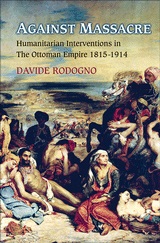
Editor-in-chief Trevor Harris
Book Review Editor Molly O'Brien Castro
![]()
Davide Rodogno, Against Massacre: Humanitarian Intervention in the Ottoman Empire 1815-1914 (Princeton & Oxford: Princeton University Press, 2011), $39.50, 391 pages, ISBN 9780691151335 — Stéphanie Prévost, Université Paris Diderot-Paris 7.
Since the 1990s, the issue of international, collective humanitarian interventions has been brought to the fore by atrocities during the Bosnian and Kosovo wars (respectively in 1992-5 and 1999), the Rwandan genocide (1994) and, more recently, by the Libyan and Syrian civil wars. However, as Davide Rodogno, Associate Professor of International History at the Geneva Graduate Institute, convincingly argues in his Against Massacre, neither did ‘the responsibility to protect’ originate in the 2001 eponymous report of the International Commission on Intervention and Sovereignty to the United Nations, nor was it a strictly post-Cold War phenomenon. Rather, humanitarian interventions, which Rodogno thinks of as ex post facto ‘coercive diplomatic and/or armed (re) action[s] against massacre undertaken by a state or a group of states inside the territory of a target state’ [2] to prevent its repetition, have older roots, stretching as far back as the late Middle Ages. Leaving aside early modern precedents of humanitarianism, which have already been the subject of Part 1 of J.B. Trim and Brendan Simms’s Humanitarian Intervention: A History (CUP, 2011), Rodogno is here ‘look[ing] at the European roots of this concept and international practice during the nineteenth century’ [1], in which non-intervention was normally the rule [21].
To do so, Rodogno has chosen to examine joint humanitarian interventions of the Great powers of Europe between 1815 and the outbreak of WW1, as applied to the Ottoman Empire, which these powers ‘increasingly saw as under their tutelage’ [9]. Indeed, from the early days of the Concert of Europe – a structure born out of the 1818 ‘European powers’ directoire’ [18], but in reality having its origins in the Congress of Vienna of 1815 – the Eastern Question has always been a very European one. It is a shame that in his section on the Eastern Question (in chapter 1), Rodogno gives only selective examples of how ‘a European power [could] come and act at will in some Ottoman lands’ [23]. He also omits to remind his readers that the Eastern Question spans a much larger period, from 1774 to 1923, and that it is actually a historical phrase used to refer to how European powers, either in combination through the Concert of Europe or more often in rivalry with each other, tried to assert their domination over that decaying Empire, while trying to preserve its overall structure for the sake of European peace. The Eastern Question was, from 1815, if not before – as Albert Sorel showed in his The Eastern Question in the Eighteenth Century (Fertig, 1969, 259) – a spectre which came to haunt the great European powers (Britain, France, Russia, Prussia, Austria-Hungary and Italy) and to threaten European peace, which the Concert of Europe was designed to maintain.
It is against this diplomatic backdrop of the Concert of Europe that, in chapters 3-10, Rodogno narrows down his scope to concentrate on the role of the British and French governments in European humanitarian interventions or non-interventions in various Eastern crises affecting Ottoman provinces (Greece, Lebanon and Syria, Crete, Bulgaria, Armenia and Macedonia). Although Rodogno somewhat puzzingly asserts a few lines apart that ‘a government always acts according to a given set of perceived interests’ and that ‘if it can be demonstrated that humanitarian motives are a pretext to enhance political, imperial, strategic interests of the intervening state(s), an intervention cannot be qualified as humanitarian’ [9], he eventually shows that the disinterestedness of the great European powers was more often than not only a front, even when they intervened on ‘grounds of humanity’. Chapters 4 and 5, respectively devoted to ‘intervention in Ottoman Lebanon and Syria (1860-61)’ and to ‘the first intervention in Crete (1866-69)’, give good examples of this. As the study unfolds, he admits that European humanitarian interventions in the nineteenth century Ottoman Empire had mixed motivations (geopolitical, economic, imperial, or ones of national prestige) and were selective as the plight of only Christians was taken into consideration by the Powers – even when retaliatory atrocities against Muslims took place, as in Crete in 1896 [215]. Besides, he convincingly posits that such interventions often were highly hypocritical as European powers sought to condemn the type of barbarous acts carried out by the Ottoman Empire which they sometimes condoned in their own colonies. Mentioning the harsh repression of the 1865 Morant Bay minor rebellion in British Jamaica by Governor Eyre and the general acceptance of Eyre’s ‘brutal savagery’ back in Britain is useful to understanding how ‘the British government hoped that the Sublime Porte would be able to master its populations as the British Empire had done in Jamaica’ [122]. In a very thought-provoking second chapter, Rodogno demonstrates how nineteenth-century European prejudices inherited from the Enlightenment against ‘the uncivilized Orient’ [37] – in particular Islamic despotism as leading to ‘unnatural sex and excessive cruelty’ against Ottoman Christians [41] – prompted Europeans to exclude the Ottoman Empire from the family of nations. The evolution of the European perception of the Ottoman Empire from ‘the terror of the world’ [23] to ‘the Sick Man of Europe’ in the second half of the eighteenth century, when it was unable to contain Russian expansionism, is core to the idea that humanitarian interventions there were not only acceptable, but just.
Early in the introduction, Rodogno carefully justifies why he chooses to focus on Britain and France by recalling that the two countries were the backbone of European humanitarian interventions in the Ottoman Empire in the period under study; he excludes other European powers, particularly the Russian Empire, on the grounds that they lacked elected parliaments [3]. A similar choice was made by Gary Bass in Freedom’s Battle (Vintage, 2008), although the latter considered the international and domestic politics of humanitarianism equally. Rodogno’s concern lies almost exclusively with the international dimension of humanitarianism, both at diplomatic and governmental levels. He concedes that ‘during the nineteenth century some massacres had a greater impact on public opinion and policy-makers than did others’ [15] and even deftly suggests that British pro-Eastern Christian pressure groups (such as the London Greek Committee, the Eastern Question Association and the Anglo-Armenian Association) had a common lineage, but fails to explain this further. He simply notes that British Liberals often spoke in favour of oppressed Ottoman Christians (Greeks, Lebanese, Cretans, Bulgarians, Armenians and even Macedonians).
In passing, one cannot but regret the maps provided in the book are undated. This is highly problematic when commenting on events taking place in an Empire that was reduced in size over the course of the period under study. The most striking example of this is provided by the juxtaposition of two maps of the Balkans in chapter 6 on ‘Nonintervention during Eastern Crisis’ [143]: there are no titles and no dates, so only experts of Eastern Question history will know that the first map (on the left) refers to the treaty of San Stefano of March 1878, which was cancelled, and the second (on the right) refers to that treaty’s replacement, the Treaty of Berlin of July 1878. Another disturbing element is the cropping up of French legal phrases in the text. While readers may appreciate knowing the French equivalent of various legal expressions, it would also have been helpful to provide comparative/ contrastive comment whenever relevant. Inconsistencies, i.e. ‘(…) “no direct interference” (immixtion directe) would be allowed’ [208] when the negatived English legal phrase in inverted commas is rendered by its opposite, are annoying. Fortunately, they remain rare.
To anyone familiar with works on the Eastern Question, it will be clear that Rodogno’s Against Massacre is yet another contribution to the dominant historiographical trend, which makes this question a predominantly diplomatic one. This approach may account for – although it does not excuse – the few inaccuracies and insufficiently nuanced statements on British domestic politics. Suffice here to give one example: Rodogno purports that the ‘bag and baggage’ policy of Gladstone of 1876 illustrates that the Liberal politician already wanted to do away with the Ottoman presence in Europe in 1858 in the context of the ‘Danubian Principalities Question’ [24]. The transcript of the House of Commons debate for 4 May, 1858 contradicts this, as Gladstone said that ‘[he did] not on this occasion inquire whether or not the Mahomedan power [could] be permanently maintained’ (Hansard, §59) and argued in favour of the union of Moldavia and Wallachia as the only efficient barriers against Russian expansionism. This is only a minor point of detail, perhaps, but one that may lead to a misapprehension of Gladstone’s extremely complex relationship to the Eastern Question, all the more so as Rodogno dubiously insists that ‘Gladstone’s involvement with the agitation was short-lived, if not ephemeral’ [152] and as he discards Gladstone’s interest in the plight of Armenians in between 1894-6 by simply saying that ‘Britain could do little’ [196]. Gladstone’s publication of Bulgarian Horrors (1876) was very likely a media stunt and it did, indeed, eventually enable him to regain the Premiership in 1880 from his arch-rival, the Conservative Benjamin Disraeli. However, works on Gladstone – including David Bebbington’s ground-breaking Mind of Gladstone (OUP, 2004) – show that, as a High Anglican, he was also genuinely concerned about the suffering of fellow Christians. Furthermore, it could be argued that Rodogno too vigorously downplays the long-lasting impact of the 1856 treaty on a whole generation of British politicians (including Gladstone, Disraeli, Argyll or Salisbury, to name but a few) as they tried to balance the preservation of the territorial integrity of the Ottoman Empire and the alleviation of the suffering of Ottoman Christians by, amongst other things, considering their nationalistic claims. The author of Against Massacre, however, does finally offer a balanced view of the powerlessness of the Concert of Europe – a realisation common to both Gladstone and his Conservative rival, Salisbury, in the 1890s – to prevent new massacres in the Ottoman Empire.
In the introduction again, Rodogno warns that ‘this study leaves aside humanitarian relief and non-military aid’ [3] as he decides to deal solely with humanitarian coercive/ military interventions at State and diplomatic levels. This was already his approach in “Réflexions liminaires à propos des interventions humanitaires des puissances européennes au XIXe siècle” published in the March 2007 issue of Relations Internationales, out of which Against Massacre has developed. There, in the 2007 article, he more explicitly relied on Martha Finnemore’s definition of humanitarianism in The Purpose of Intervention (Ithaca, 2003) so as to concentrate on coercive, military interventions only [16]. While this focus may be pragmatic in terms of managing the book, one does wonder whether the humanitarian Concert and gunboat diplomacy upon which he concentrates can really be so neatly separated from what is now known as ‘humanitarian diplomacy’. Current discussions of contemporary humanitarian diplomacy – or of ‘intervention diplomacy’ or ‘disaster diplomacy’ which are alternative concepts, according to Philippe Régnier’s December 2011 article ‘The Emerging Concept of Humanitarian Diplomacy’ (The International Review of the Red Cross, vol. 93, n° 884) – tend to stress the inter-relationship between the actions undertaken by non-governmental organisations and the local structure they set up. Michelle Tusan’s examination of ‘hands-on diplomacy’, in her recent Smyrna’s Ashes: Humanitarianism, Genocide and the Birth of the Middle East (University of California Press, 2012, 93), suggests local actors were equally important in the nineteenth-century. She explains that British humanitarian enterprises in the Ottoman Empire after 1876 increasingly relied on the (sometimes active) co-operation with members of the local diplomatic corps (the ambassador at Constantinople, consuls and vice-consuls). The fact that Rodogno does not even mention, let alone discuss, this is all the more surprising as he is prolific in detail about the role of local diplomats to move powers to action. For instance, we learn about the diligence with which Philip Currie, British ambassador at Constantinople, denounced the Armenian Massacres of 1894-6, but his official actions as co-ordinator of international relief at Constantinople are not mentioned at all. By contrast, Rodogno simply comments that the transnational extraparliamentary Pro-Armenia pressure group tried to force European powers to intervene on behalf of Ottoman Armenians [207]. Again, the ties between the national branches of Pro-Armenia (in France, Britain, Italy, etc.) and these governments deserve further exploration.
Rodogno’s study is, in the end, well-written. It retraces the history of humanitarian policies in Eastern Question diplomacy, gives the legal European framework for these interventions and, more broadly speaking, reflects on the reluctance of European powers to intervene. Rodogno announces in the introduction that he will explore the nineteenth-century European roots and practice of humanitarianism, and he does so. The fact that he recalls that the very term ‘humanitarianism’ was negatively connoted for most of the nineteenth century sets the scene for his study. But the greatest merit of Against Massacre, by comparison to Bass’s Freedom’s Battle, probably is his broader perspective – la longue durée – that invites us to look into the humanitarian interventions of the Concert of Europe in the Ottoman Empire as episodes that still frame today’s international politics of humanitarianism. Early on, in chapter 1, a discussion of terms used then and/or now (in particular ‘massacre’, ‘atrocity’ and ‘extermination’) and of the evolution of terminology in treaties, prepares us for a comparison between nineteenth-century humanitarian interventions by the Concert of Europe in the Ottoman Empire and post-WW1 humanitarian interventions by the League of Nations and the United Nations. Surely, the presentation of ‘capitulations’, i.e. rights and privileges granted by successive Sultans to Christian countries in favour of their subjects residing or trading in the Ottoman Empire from the sixteenth century onwards, as ‘a perfect example of European imperialism’ [29] provides a thought-provoking starting point to reflect on today’s humanitarian interventions as acceptable or ‘unacceptable assault[s] on sovereignty’ [275] and to balance out ideas of legal and moral duties.
Undeniably
it is this larger matrix stretching from 1815 to today, and the fact
that Rodogno manages to show the continuities and rifts of international
humanitarian policies over that period, that makes this historian’s
Against Massacre a worthwhile read for anybody interested
in international politics and the intellectual history of humanitarianism.
© 2013 Stéphanie Prévost
& GRAAT
Senior
sub-editor: Hélène Tison
lntison@yahoo.fr
Webmaster Georges-Claude Guilbert

